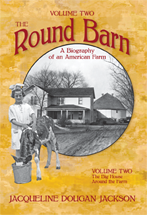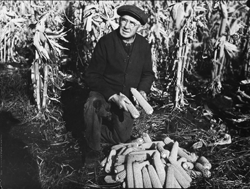Announcing the publication of Jackie Jackson's life work:
“Jackie Jackson throws open the Round Barn doors at the Dougan family farm to tell us an American story. She gives us a rich history of farm life at the mercy of the forces of science and the market but grounded in rock-solid Wisconsin values.” Dick Durbin, U.S. Senator
Chapter from VOLUME 2
This story is from The Round Barn, Vol 2. Want to read more stories from the Round Barn? Order Volume 2 below or enter our discount code.

VOLUME TWO:
The Big House
Around the Farm

Grampa displays a few of Heaven's finest
Cornshock Tepees
It’s a sunny fall day, and Jackie, Craig, Patsy, and Joan are playing house in the cornshock tepees in the field across Colley Road. Jackie is seven; she’s played house in cornshocks every fall since she was born. A cornshock is made of bundles of cornstalks stacked upright against each other, and the way to turn one into a house is this: You select a tepee that has a likely gap between the bottoms of two bundles. You pull and push to make the gap bigger, and then, down on your knees and stomach, shove and hunch and worm your way into the shock. In the middle there is a little space where the original two or three bundles were propped together, tripod fashion, to start the shock. Inside the tripod you can almost sit up, and by more shoving, with arms and shoulders and back and feet, you can either move or compact the stalks till you have a small parlor, with space to entertain one or two cramped visitors. You burrow out to make a back door, too. Once the house is finished you visit back and forth across the corn row stubble to other houses. You bring out your dolls and stuffed animals. For your larder, an adjoining crevice, you carry out chocolate milk and orange, and you raid the orchard for apples, and the garden for anything still in the ground, such as a stray carrot or parsnip. This fall Patsy is being very mysterious about her house. She won’t let anyone in. But after a bit she has to fare forth for more materials, and then they see what she’s up to. She is paving her house! She’s husked the dry corn ears from all the exposed stalks inside and outside her dwelling and hammered them into the ground like bricks. Now she goes around to the other cornshocks and gathers more ears. She plans to pave her house all the way from its front entrance through to the little center room and out the back door. Jackie marvels. A yellow floor! It’s hard like a floor, and each brick is slightly humped. The whole pavement has a pebbled effect, on account of the kernels. Craig and Joan also admire the improvement. Their own dirt floors now look shabby. Patsy explains how she had her happy inspiration while the rest rush to husk ears and pave their houses, too. In a short while, all four entrances are aglitter in the autumn sunshine. Joan arranges her ears in a crisscross fashion, to make a parquet pattern. Patsy finishes, and adds a vestibule. They all save the dry brown cornsilk to make little pillows, for the gleaming floors are not too comfortable to sit on. They see Grampa heading toward the orchard. They hail him. They want him to come into the field and look astonished at their houses. They want him to burrow on his hands and knees over their elegant yellow pavements. Grampa sees their beckoning. He veers and comes across the stubble. His face is filled with mirth. Patsy rushes to show her house first, because she had the idea and besides, hers is finished. Grampa beams until he gets to Patsy’s door. Suddenly his face changes. It becomes stern. He bends and looks into Patsy’s house. He stands up again and looks at the other three houses. All the while he shakes and shakes his head. Patsy and Joan, Craig and Jackie, are dashed. “Cubbies,” says Grampa finally, “don’t you know why the corn is shocked this way?” The four shake no. “It’s to keep the corn dry during the winter, so that as it’s needed, the men can load it and bring it into the barn for the animals. The corn you’ve husked will freeze into the ground. The kernels will rot. And the mice will find it easy to get at, and the pheasants. You’ll have to dig it all up and bring it in to the corn crib.” Grampa squats and pries up an ear from Joan’s patterned hallway. He turns it over. Earth is caked between the kernels. He shakes his head again. “You’ll have to take a stout brush and get out all the dirt, too,” he says. The four stand dispirited as Grampa leaves. Then they begin to dismantle their pavements. “Well,” says Craig, “I’m glad I only got mine half done.” “You can go get the wagon,” Joan says curtly. Craig fetches the silver wagon. He brings a stiff brush from the barn. It takes several hours and many trips to get all the corn to the corncrib. They can’t pile the wagon very high or the ears fall out. Even level, they bounce out as the wagon bumps over the ridges in the field. It’s an unhappy job. They are snapping and snarling at each other long before it’s over. As they are hauling in the last load, Grampa comes out of the tool house. They indicate to him that they’re finished. They offer an ear for his inspection. They pant and stagger and roll their eyes, to show him what an awful job it’s been. Grampa nods approval. His silent laughter is sympathetic. He says, “You’ve heard of Heaven, where all good cubbies go?” The four nod. “And that the streets there are paved with gold?” The four nod again. “Well,” says Grampa, “when Saint John had his vision, and wrote it all down, he forgot to tell us an important detail. But I’ve had my own vision, this afternoon, and now I believe I can fill in the Scriptures.” His eyes twinkle. “Do you think the Lord would use anything but the very finest gold?” The four shake their heads. “And what’s the finest sort there is?” The four begin to smile. Grampa bobs his head vigorously. “Yes, I agree. When you and I get up to Heaven, we’re going to find that golden paving made of -- ” He pauses, holds up both hands, looks merrily enquiring. “CORN!” cry all four in chorus. “Corn,” repeats Grampa firmly, dropping his hands onto his overalled knees.—from Volume II, Book 3
